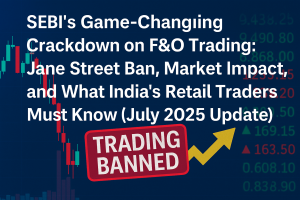Introduction

In a bold move that has sent ripples through India’s financial markets, the Securities and Exchange Board of India (SEBI) recently cracked down on questionable practices in the Futures & Options (F&O) segment by Jane Street. The most striking action was the ban on Jane Street, a global trading firm, for alleged manipulation of the Indian derivatives market. This has sparked intense discussions about the future of F&O trading, the role of retail investors, and SEBI’s regulatory tightening.
In this post, we break down:
✅ What exactly happened
✅ Why SEBI intervened
✅ How the changes impact retail traders
✅ Smart tips to survive and thrive in this changing landscape
What Happened? The Jane Street Ban & Market Reaction
In early July 2025, SEBI barred Jane Street from India’s markets after investigations revealed potential misuse of options trading for index manipulation. Along with freezing ₹4,700 crore (~$567 million), SEBI’s move led to an immediate drop in options turnover.
📉 According to market data:
- Index options turnover halved within days of the Jane Street ban.
- Bank Nifty and Nifty option volumes fell sharply.
- Liquidity in intraday options trading dried up, hurting both institutions and retail traders.
At the same time, a SEBI-commissioned study revealed that nearly 91% of individual F&O traders in India lost money in FY25, with cumulative losses crossing ₹1.06 lakh crore.
Why Did SEBI Crack Down on F&O?
SEBI’s actions were driven by:
🔍 Concerns over market manipulation
🔍 Explosive growth of speculative F&O trading by retail investors
🔍 Surge in algo-trading and high-frequency trades that can distort markets
With India’s F&O market becoming the world’s largest by volume, SEBI sees this as a crucial time to introduce stricter rules to protect investors and ensure market stability.
Key SEBI Rule Updates for F&O (July 2025)
- ❌ Ban on pre-payment penalties (part of broader reforms across financial products)
- ❌ New restrictions on maximum open positions in index options.
- ❌ Clarification: No proposal to link leverage limits to cash positions—for now.
These moves aim to curb reckless speculation without fully shutting down the thriving derivatives market.
What Does This Mean for Retail Traders?
⚠️ If you’re an Futures & Options (F&O) trader in India, these recent developments could have a significant impact on how you trade and the strategies you use.
1️⃣ Short-Term Market Changes:
With the Jane Street ban and SEBI’s stricter scrutiny, the market is already witnessing:
- Lower liquidity: This means fewer active buyers and sellers, making it harder to enter or exit trades smoothly.
- Wider bid-ask spreads: The difference between buying and selling prices is increasing, which directly adds to transaction costs and reduces profitability for frequent traders.
2️⃣ High Trading Costs in India:
India’s options trading costs remain among the highest globally due to high Securities Transaction Tax (STT) and brokerage charges. Market veterans like Shankar Sharma have openly criticized this, calling India’s derivatives market “frightfully expensive” for retail participants. These high costs eat into whatever slim profits most retail traders manage to make.
3️⃣ Impact on Intraday Speculation:
With tighter regulations and reduced volumes:
- Speculative intraday trading in Bank Nifty and Nifty could decline as traders face higher costs and lower liquidity.
- High-frequency trading and short-term positional strategies, which were popular for quick gains, may no longer be as viable or profitable.
4️⃣ Rethink Risky Strategies:
Retail traders who were heavily reliant on:
- High leverage
- Out-of-the-money options bets
- Short-term expiry chases
may need to reconsider their approach. The environment is shifting toward more regulated, risk-controlled participation, and SEBI’s measures aim to protect retail investors from excessive losses.
✅ Key Takeaway for Retail Traders:
This is the time to move toward:
- Well-researched, lower-risk strategies
- Index-based or hedged positions
- Reducing overexposure to speculative trades
The focus should shift from fast profits to sustainable wealth-building.
Pro Tips: How to Trade F&O Safely in India
✅ Focus on index-based options strategies like covered calls or spreads.
✅ Limit exposure to highly volatile instruments.
✅ Never risk more than 1-2% of your capital per trade.
✅ Consider mutual funds or index ETFs for core wealth building.
F&O can still be used effectively for hedging and strategic positioning—but not for gambling.
Conclusion: The Future of F&O in India
SEBI’s crackdown, highlighted by the Jane Street ban, marks a turning point for India’s booming derivatives market. With stricter surveillance and growing scrutiny, retail traders need to adapt, act responsibly, and avoid the pitfalls of short-term speculation.
The goal is clear: build a market that’s both fair and sustainable—where investors can thrive without taking on undue risk and fair strategies.
What are your views on this news and the sebi action on it.
Open Demat account using:
Upstox: https://upstox.onelink.me/0H1s/2QBH4Y
Zerodha: https://zerodha.com/open-account?c=UI9061
FundsIndia:https://www.fundsindia.com/registration/signup?referrer=14c986bdd27841eabe42ce2aaa37815b


